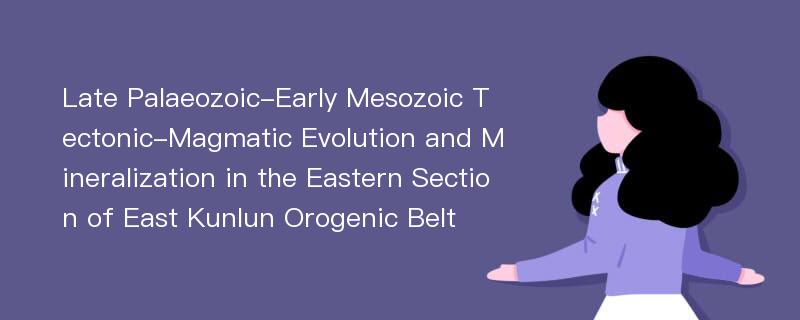
论文摘要
The East Kunlun Orogenic Belt(EKOB) is located at the west of the Central Orogenic System of China(Fig. 1), reserved complex and multiple tectono-magma events occurred in the past hundreds of million years as a compound continental orogenic belt(Meng et al., 2015; Yu et al., 2017; Chen etl al., 2018; Li et al., 2018; Dong et al., 2018; Pei et al., 2018). Thus the magma carried abundant ore-bearing fluid from deep of the Earth to form large-scale polymetallic deposits. For instance, deposits of Cu, Au, Pb, Zn, Ag and Ni, and provides an ideal place for studying the relationship between magmatism and metallogenesis. Overall, the tectonic evolution of the EKOB from Late Paleozoic to Early Mesozoic can be divided into three stages, i.e. oceanic crust subduction stage(277-240 Ma), syncollision stage(240-230 Ma) and post-collision stage(230-200 Ma). Crust-mantle magma mixing and mingling occurred during the whole evolution process of the paleo-Tethys Ocean. The mafic plutons are most likely derived from partial melting of metasomatic mantle wedge with subduction fluid. Most of the granites magmatites are partial-melting products of lower crust. The crust-mantle magmatic mixing in the subduction stage of the eastern part of the East Kunlun orogen not only brings mineralization materials and result in the enrichment of some elements, but also brings heat source. After the change of the physical and chemical conditions of the ore-forming flow, a large number of mineral deposits. The main metallogenic combination is Cu, Mo, and Au, generating small deposits in size.In the syncollision stage, due to the compressive stress, the magmatic rock developed rarely, and the ore deposits distributed along the faults of the EKOB, andthe main ore metal were Cu, Mo, and Au. In the post-collision stage, as a result of delamination of the lithospheric mantle in the extensional environment, which provides a channel for mantle materials to participate in mineralization. Especially, the conversion stage from the collision to the post-collision stage is the peak period of Late Paleozoic to Early Mesozoic metallogenesis in the area, such as Cu, Pb, Zn and Fe.
论文目录
文章来源
类型: 国际会议
作者: CHEN Guochao,PEI Xianzhi,LI Ruibao,LI Zuochen,PEI Lei,LIU Chengjun,CHEN Youxin,WANG Meng,WEI Junqi
来源: 第九届世界华人地质科学研讨会 2019-06-01
年度: 2019
分类: 基础科学,工程科技Ⅰ辑
专业: 地质学,地质学,矿业工程
单位: School of Civil Engineering, Nanyang Institute of TechnologyFaculty of Earth Science and Resources, Chang’an University, Key Laboratory of Western China’s Mineral Resources and Geological Engineering,Ministry of Education, MLR Key Laboratory for the study of Focused Magmatism and Giant Ore DepositsKey Laboratory of Rare Mineral, Ministry of Land and Resources
分类号: P588.11;P611
DOI: 10.26914/c.cnkihy.2019.028374
页码: 170-171
总页数: 2
文件大小: 128k
下载量: 5
